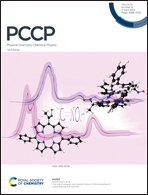Regulating through space charge transfer in thermally activated delayed fluorescence molecules via donor architectures: theoretical perspective and molecular design†
Abstract
In recent studies, thermally activated delayed fluorescence (TADF) molecules with a through space charge transfer (TSCT) feature have attracted wide attention. Nevertheless, studies on the substitution effects on the photophysical properties of TSCT-based TADF molecules are insufficient, and the corresponding theoretical investigations and effective molecular design strategies are highly desired. Herein, in order to reveal the inner mechanisms between the substitution effects from the donor unit and the luminescent properties for TSCT-based TADF molecules, the photophysical properties of nine TSCT-based TADF molecules (including one molecule with dual configurations) are theoretically studied. Based on density functional theory (DFT) and time-dependent density functional theory (TD-DFT) coupled with the thermal vibration correlation function (TVCF) method, basic physical parameters such as geometric changes, electron-donating abilities, adiabatic singlet–triplet energy gaps, TSCT ratios, hole and electron distributions and excited state decay rates are calculated and analyzed. The relationships between molecular structures and luminescent properties are determined. Our results show that molecules with carbazole as the donor possess large oscillator strengths and transition dipole moments, and a prominent radiative decay process is determined. Moreover, molecules with phenazine as the donor present small geometric changes, strong electron-donating capability and tiny adiabatic singlet–triplet energy gap, and all these factors contribute to the effective reverse intersystem crossing process (RISC), and this feature makes these molecules promising TSCT-based TADF molecules. Furthermore, dual configurations for 2CTF molecules are determined (2CTF2.1 and 2CTF2.2), and 2CTF2.1 with a large TSCT ratio possessing a fast fluorescence decay process and high luminescence efficiency can be achieved. As for 2CTF2.2 with a small TSCT ratio, a remarkable RISC process is determined and high exciton utilization can be realized. Thus, 2CTF can be regarded as a self-doping TADF molecule and a remarkable TADF feature is detected. Our investigations provide a perspective for experimental measurements and propose an effective design strategy for efficient TSCT-based TADF molecules.



 Please wait while we load your content...
Please wait while we load your content...